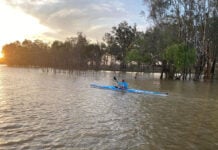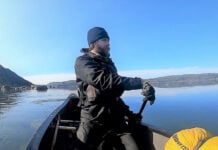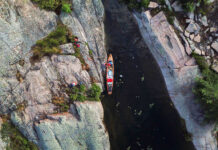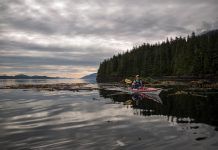This lunch stop on Bigsby Island in Lake Huron was a special moment. My daughter and I were 22 days into a 32-day tandem expedition across the great lake, starting from Bootaagani-Minis (Drummond Island) in Michigan, with the goal of reaching Penetanguishene in Ontario, Canada. We traveled on a 14-foot-long Blu Wave SUP Catalina.
Early in the expedition, we both contended with concerns over the challenges ahead and our precious cargo on board. For me, that meant my nine-year-old daughter. For my daughter, Acadia, it meant the glass vials containing water samples we were collecting along the journey and the equipment for microplastics sampling.
Father-daughter tandem expedition explores Lake Huron
The expedition started as an idea to trace the 1828 migration of my Metis ancestors across Lake Huron, from Drummond Island to Penetanguishene. It was Acadia’s idea to turn the trip into an environmental journey and take water samples for microplastics research, something she learned about through the Lake Huron Coastal Centre for Conservation. We carried with us a deep-water sampler and collected some of the first deep water data for Lake Huron, so we could learn more about the threat of plastic pollution.
We experienced the full monty of weather, wind and waves as we traveled the coastlines of Lake Huron’s three bodies of water—the North Channel, Lake Huron proper and Georgian Bay. The lake’s long shorelines present unique challenges to navigate. Along the eastern shoreline of Manitoulin Island, the largest freshwater island in the world, the winds turned with us, and we journeyed consecutive three-leg days, paddling in the morning, afternoon and evening. Along the north shore of Georgian Bay, we had strong winds and half-meter chop hitting us broadside but were able to bounce forward using the inlets and islands as handrails.

A welcome break at Bigsby Island
Here at Bigsby, we had reached the archipelagic eastern shoreline of Georgian Bay. And with approximately 300 kilometers of our journey behind us and a little more than 150 kilometers ahead, we were paddling into the labyrinthine Thirty Thousand Islands region. The day had been piping hot. Having paddled 15 kilometers that morning, we opted to relax for the afternoon and resume paddling later that evening. We took a water sample and cast a line. We caught a smallmouth bass and shared a shore lunch and a swim.
In this photo, Poly, the polypropylene waterfowl—a duck decoy we’d been trolling behind us since finding it washed up on Greene Island—watches over Acadia as she loads the water sampling gear on the SUP. The block of blue foam, small plastic bucket and oil can on board were removed from islands along the way. We found plastic garbage at every campsite, lunch spot and pee break we made. We hauled out what we could.
As for the water samples? Microplastics were present in 42 of the 44 samples analyzed, mainly in the form of fibers. Those deep-water samples proved the presence of microplastics at depths of 50 feet in some channels.
Everything is interconnected
Since this transformative journey in July 2019, I’ve seen how prevalent microplastic pollution is across Lake Huron and how it has permeated the habitats of all wild creatures across the region. The journey also underscored the interconnectedness of all things—Acadia recognizes the water we swim in at home is affected because it’s all the same system. Through our documentary, Three Waters, we hope to bring the same realization to everyone connected to the Great Lakes region.
The Three Waters documentary about this expedition premiered in April 2022. Find screenings near you via writer Scott Parent’s Instagram @scottparentphoto.
Respite on Bigsby Island, Georgian Bay. | Feature photo: Scott Parent



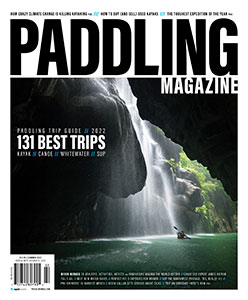 This article was first published in the Summer 2022 issue of Paddling Magazine.
This article was first published in the Summer 2022 issue of Paddling Magazine. 
